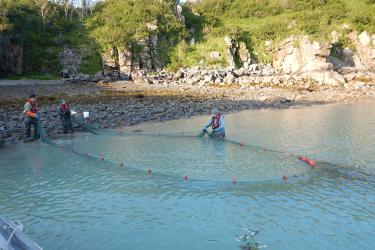
Some of the most important tools of science.
Like most science jobs, field or lab, most time is spent on paperwork. Data collection ends up being mostly putting pencil to paper- observing is no different. We collect a myriad of types of data vital to the conservation and sustainable management of our oceans’ natural resources. Catch effort information like when, where, and how long boats fish, how much they catch, what they keep, and what they discard. We take data on individual fish like sex, lengths, age (via otoliths, a small bone in the “ear” of the fish responsible for balance that grows rings like a tree). We take data on other critters including seabirds, marine mammals, events like marine pollution and accidents, etc. The vast majority of this is done using pencil and paper. I’ve come to really appreciate those tools that are the essential, universal means of information conveyance that are also universally taken for granted. All of our data forms are specialized, but our deck sheets take the cake. Thin, satin plastic sheets made to function like paper that are waterproof and impossible to tear without tools. We use them every day, inside and out, in freezing cold, blowing spray and crashing waves of the weather deck or in the misty, slimy factory.
There are downsides to these sheets- they smudge, the waterproofing makes using pens impossible, and mechanical pencils tear and delaminate them. So, we’re issued a pouch that comes with Dixon Ticonderoga HB #2 pencils (the classic, yellow and green school pencil) and General’s Kimberley 3B brass-ferrule drawing pencils. You’re supposed to use the Ticonderogas for paper forms, which you can erase and correct. The Kimberleys are for deck sheets, since they write very dark and are easy to read, but have no eraser, because they represent the final tally and we want to maintain the integrity of the scientific method and the legal status of our data.
These are good pencils, for sure. But, with my experience, I have realized they aren’t ideal. The Kimberleys are for *drawing*, NOT writing. They have no eraser because in sketching, erasing isn’t important and the soft graphite is designed for light strokes on sketch pads, while heavy pressure produces dark, smooth lines. For writing on plastic sheets in 30mph wind with freezing spray spattering your clipboard? I’d rather use a crayon. It’s dark mark is the ONLY thing that was considered in its selection. The problem is, it’s so heavy that it actually *runs* like ink when wet and if touched, the resulting smudge will be worse than charcoal on an apron at a summer barbeque. The lack of eraser is merely an insult to our integrity and intelligence, since I guess it is thought that if there isn’t an eraser, you won’t think to use a different pencil to erase it, if you are of such an unscrupulous alignment that you would imagine such a thing.
For my deck pencils, I use Palomino Blackwing 602’s wrapped in electrical tape for waterproofing. They’re expensive, but worth it. It’s a revival of a top-quality pencil no longer made, but coveted by collectors- the Eberhard-Faber Blackwing 602. It had a unique replaceable rectangular eraser, a mixture of wax and graphite formulated to mark with the smoothness and speed of a drawing pencil, but with the low wear-rate and smudge-less traits of a writing pencil. Its use spread from the stenographers it was designed for, into the hands of the world’s best writers, like Stephen Sondheim, John Steinbeck, etc. Today, Palomino makes a clone of the 602, with a flashy silver body, stamped with their golden logo. It’s perfect for the job.
I’m less picky when it comes to “housecat” paperwork. I’ll even use a Ticonderoga, but the Mirado Black Warrior and Mitsubishi 9850 are my standbys. The “BW” is a matte black, round-body HB #2- the finish provides a comfortable grip. The 9850 has a deep maroon, hex-body and a silver embossed logo, topped with a white eraser. It’s gorgeous, and hopefully some of that sophisticated Japanese engineering rubs off on an exhausted, slime-crusted observer filling out blanks after 3 hours of sampling.
Doesn’t matter what pays the bills for you, at one point you realize the things that matter most to your job performance are the details that never seemed to matter before. You refine techniques over time and small changes can produce big results. I am no different and choose to use quality tools to perform tedious tasks that my quality of work depends on. Why use poor tools to do a great job?




